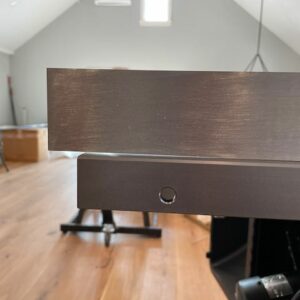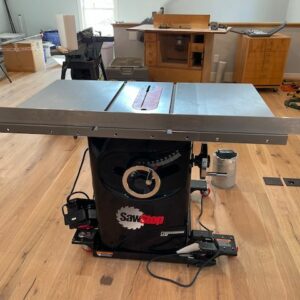I’ve a new 3HP PCS that I’m assembling. One of the wings is drooping by 0.028″. Which doesn’t seem like much but is visually noticeable and more so w/ a straight edge (photo).
Sawstop’s suggestion was to mount the angle irons on the front & back of the table and far wing and then use C clamps to pull the drooping wing up and then tighten the bolts between it and the angle iron. Which kind of surprised me. (and FWIW, they did say that if this didn’t work that they’d send a new wing even though their official tolerance is 0.030 to the wing edges).
Other’s thoughts on this?
I’ve seen all too often how a small error compounds in a project further down the line. Am I being over picky about this or would others think the same as me? Is this likely to work well for the next couple of decades or become problematic?
Thanks,
















Replies
First see if there are any obvious bumps thay can be filed to correct it, but don't pick up the file until you have an email from SS to go ahead and try. I had to shim mine, but I guess I was lucky that it was the opposite direction. A gap in the top collecting debris would bug the s**t out of me. Fore & aft is less of an issue in my mind than left to right. Have them sùpply the new wing if they are willing.
If the droop is the same front and back, you can use layers of thin strips of blue tape (1/4- 5/16" wide) at the bottom, below the bolts holes that mount the wing to the table , to raise up the far side.. That is what I used to setup a saw stop wings in the past.. the blue tape will compress and make sure each layer is the same width.. end to end..
I wouldn't be happy with a new cast iron top being off by 1/32 inch.
That said, I agree with the above comment - If the droop is the same front-to-back, then simply shim the joint. Also, check for debris in the joint or rough mill marks on the mating edges.
Like you, I would be uncomfortable with using a C clamp to attempt to force it. You don't know if the wing will flex or if the main top will flex.
Can you tell from measuring the gap under the straightedge if the drop starts at the interface between the tables or if the extension table curves downward as the picture seems to show ? I assume you are using feeler gauges to measure the gap between the straightedge and the extension table so the gap should grow evenly from a few thousands at the joint between the tables to 0,014 halfway to the outer edge etc… otherwise, you have a bent table.
Thanks all. I'll be back in the shop later this afternoon to verify but…
- I did take the wing off and wiped both mating faces and put back together w/ the same result.
- It is roughly the same front to back. Front is 0.028 low, back is 0.027 low. These are the same whether straight across or diagonal.
- I believe the wing itself is flat but will verify. E.G., it appears to be that one or both mating surfaces of wing & table are off.
- The gap does steadily increase from apparent 0 at where it mates w/ the table to 0.028 at the outer edge. Not undulations that I remember but will verify.
FWIW, the table is flat (they did have to send me a new table as the original was convex by something like 0.038 IIRC). The right wing is flat and these two together are flat. And here by flat I mean within about 0.004".
More later. Thanks all.
Wings not aligning perfectly flat is not an unusual thing in my experience with a half a dozen various tablesaws. Cast iron can flex more than you think and bringing things into alignment is not really a challenge.
I use foil tape since the tape sticking in position makes life easier for me. I have used strips cut from aluminum cans or brass stock in the past but it can be a pain keeping things lined up.
Once I have things in the ball park I clamp and tighten one end of the wing. The other 2 or 3 bolts are left pretty snug but not final-tight. I use a dead blow hammer to align the second bolt position and then tighten it. Same for the third and or last.
Once everything is at an acceptable alignment I tighten things pretty well. I do find that adding or replacing the washers supplied with thick fender washers supplies a greater bearing surface and keeps thing in place with less torque and for a longer period.
Finally got to the shop… 10"of wet snow and flu are not a nice April Fools :-)
I took the wing off and rotated it 180° and it's now 0.003. Also discovered the wing is concave in the middle by ≈0.019 which I'd not noticed or measured when that edge was outboard but was obvious mated against the table edge.
Reversed and now the outer edges are low again measuring 0.031 & 0.029 low.
So, am I thinking correctly that it is HIGHLY LIKELY the mating edge of the wing is off and a new and accurate wing is the solution?
Thanks,
I'm wondering if I should try swapping the wings. If only one of the four faces is off and that is outboard is there a reason I should care?
This forum post is now archived. Commenting has been disabled